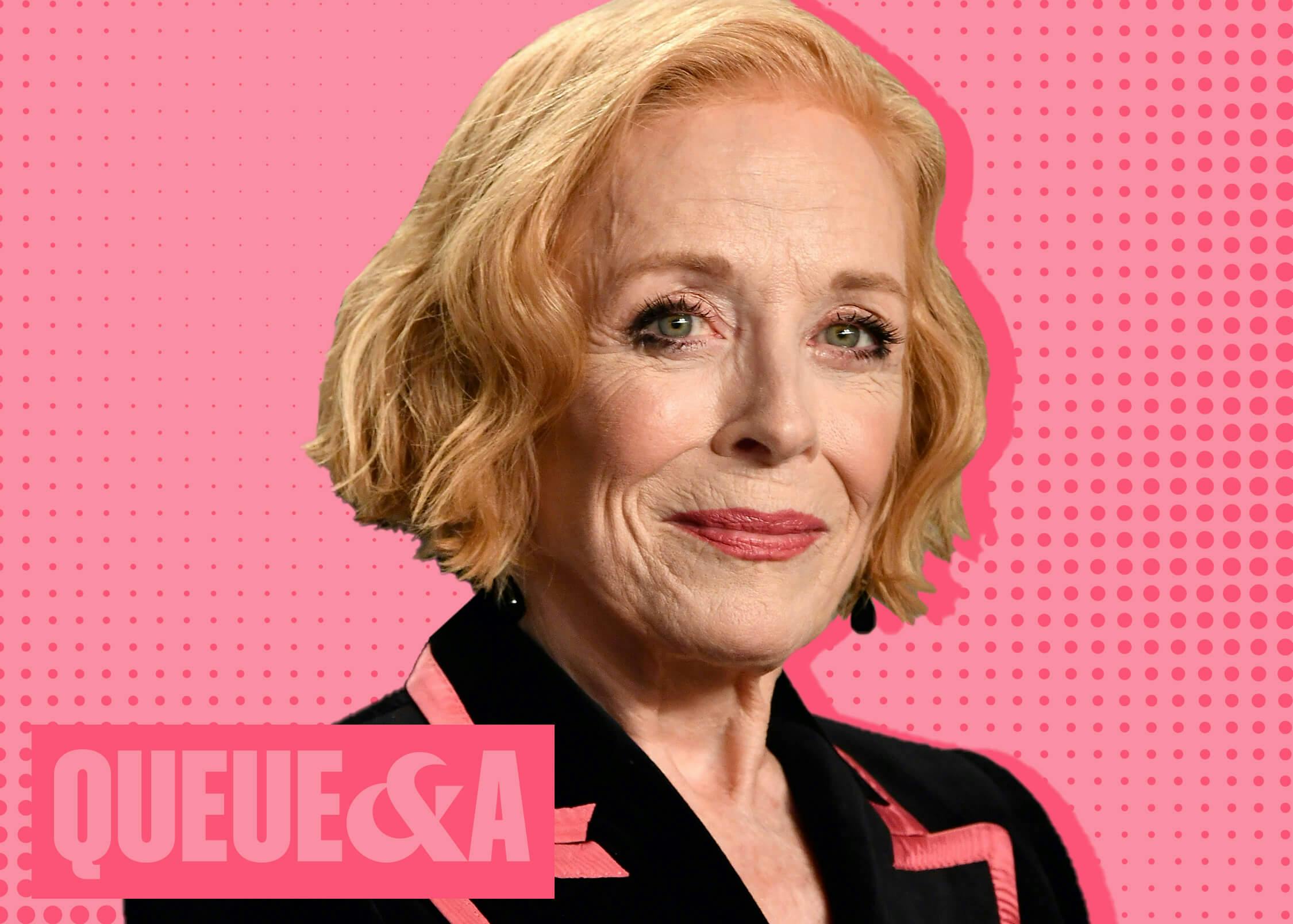Netflix stars answer Queue’s questions about creativity and craft.
Holland Taylor’s career is enviable; she’s acted in a wide range of some of the past century’s most beloved films (Romancing the Stone, Legally Blonde, The Truman Show) and enduring TV favorites (The Practice, Two and a Half Men, Bosom Buddies, The L Word). She’s taken home an Emmy for Best Supporting Actress in a Drama Series and has been up for the award eight times. More impressive, the vivacious actor didn’t begin her onscreen career until her mid-thirties; Taylor got her start in the theater and even wrote and starred in her own one-woman play, Ann (based on the life of feminist politician Ann Richards), which earned her a Tony Award nomination for Best Actress.
Taylor currently works her magic in the new Netflix series The Chair, where she plays Joan Hambling, a medieval literature professor in the crumbling English Department of the fictional Pembroke University. In the show, a seasoned Professor Hambling mentors the newly appointed, first female chair of the department, Professor Ji-Yoon Kim (Sandra Oh), and struggles to engage the social-media generation in reading Middle English authors like Chaucer. Queue spoke with the talented actor about her latest role and the path she took to get here.
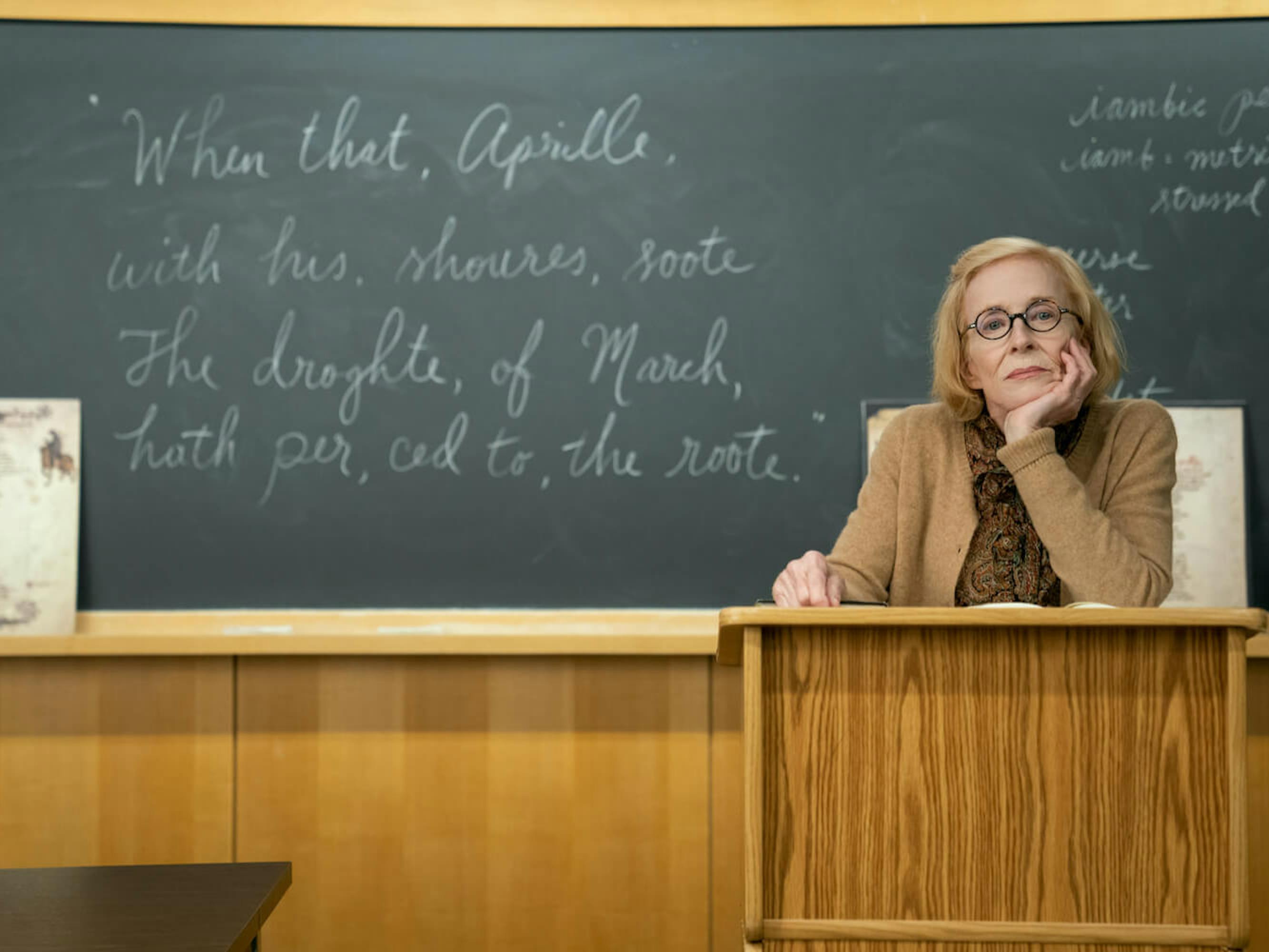
Professor Joan Hambling (Holland Taylor)
Queue: Was there a film or television show that made you fall in love with acting and what was it?
Holland Taylor: Wow. I don’t remember when I fell in love with acting; it was all in my childhood. I’d been going to movies and then I don’t know when I found out that you could be in them. But, I mean, from before I was a teenager — at age 8, 9, 10 — I already knew. I have no idea what won me over — that’s just what I was going to do.
You play a professor in The Chair. Did you have a teacher or professor who made a difference in your life?
HT: Many. Mostly they made a difference by not just pointing at it, but by being living examples of the joy of knowing things, the joy of understanding something. I had a chemistry professor who was just inflamed with the fascination of it all. I wasn’t that interested in chemistry, but I was interested in his delight in it. I had a history teacher who just loved telling the stories about what he was going to teach. He would flesh out the facts that we were reading and would add some tidbit, some texture of real life to it. You’d just sit there with your jaw hanging open. If you captured my imagination, which a lot of my teachers did, I was a very good student.
My acting teacher, Stella Adler, was a very special circumstance because she was one of the great acting teachers, a great actress, and a great theatrical aristocrat. She was eighty something when I started studying with her which was around ’80, ’90, ’91 — in that period. She was just a burning sun of passion and knowledge, a great intellect, as well as an artist. She changed my life, absolutely. I was not a kid when I studied with her, I was about 35, but I was really primed to learn.
Can you tell us about your first role in the entertainment industry and how it felt when you learned that you booked the gig?
HT: Well, I worked a little bit in Summer Stock when I was a teenager. That was all very exciting, but chaotic and I was a kid. My first show in New York was, incredibly, a Broadway play. I got to do that play because I went to an open call where anybody who’s an actor can just come to that call. The play was called The Devils. It starred Anne Bancroft and Jason Robards. There were parts for, like, 20 nuns. I figured, I’m going to play a nun in the show — that’s all that’s going to happen.
I auditioned for it and I did get it. When they called me, they said, “We’d like to hire you to understudy Sister Louise and be in the chorus of nuns for The Devils, and the pay is going to be $125 a week.” I said, “You’re going to pay me? You’re going to pay me?” They said, “Yes.” It was incredible. I actually even said this to her. I said, “But that’s exactly how much the radio I’ve been wanting to buy costs.” It was a Phillips Norelco radio. There is memory for you, $125 bucks in 1965. There you have it.
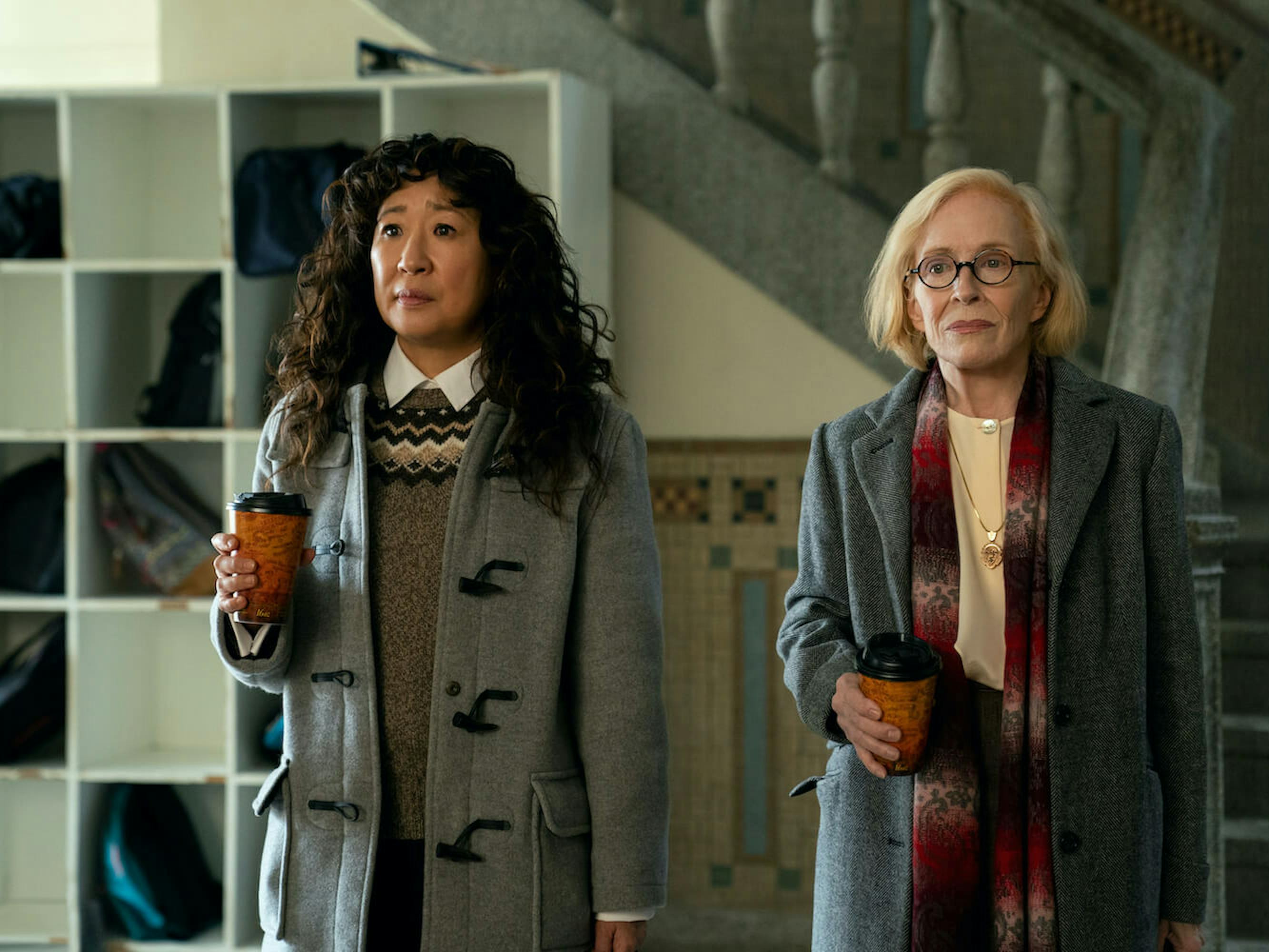
Dr. Ji-Yoon Kim (Sandra Oh) and Professor Joan Hambling (Holland Taylor)
Do you remember the first time you saw yourself on camera or onscreen and what that was like?
HT: I think it was a Shakespeare thing I did for PBS, when I was, I don’t know, 25 or something ridiculous. I was so upset with how I looked and how I sounded that I stopped watching myself in things. I very, very rarely watch myself in things. I’ve seen The Chair though. It was a wonderful show.
What was it like to work on The Chair? Can you tell us a little bit about working with this cast and working together as an ensemble?
HT: Well, we were an ensemble with a difference because normally actors hang out, particularly if they’re on location in the city. You don’t know anybody there so you hang out with the cast and you eat with the cast, or you go to the museums with the cast. You get to know people better. You’re hanging out at their hotel. You have a drink down at the bar. We did none of that. This is the middle of a global pandemic, something that happens once in a century, which is a significant measure. Here we were, in this freezing cold winter town, in hotels that generally didn’t serve food because hotels didn’t do that during the pandemic in those early months. The only time where one was happy and felt human was when we were together working. That’s the only time we had to hang out.
I think we really got all the humanity we could get from each other’s company. And I think every one of us loved the writing of this show and loved Sandra’s [Oh] leadership and loved our relationship to Sandra and Jay [Duplass]. Amanda Peet, who created and wrote it, was a presence. She was almost always there except when she went home every weekend to be with her children and her husband. We really clung together. That was it for our human engagement.
The miraculous thing is, it certainly educated me. I did not know how nourished I was by art and by creative work. I could live on it, because we discovered that that’s what we were doing; we were living on it. The one time I went into a great art museum, I almost burst into tears because I’d been deprived of it for so many months. I realized how much it meant to me then. We all had a very meaningful time together, but we didn’t hang out away from work because we couldn’t. That’s rare.
When you were doing your preparation for the role, was there any sort of inspiration or research that you did specifically for the character of Professor Joan Hambling?
HT: Well, Professor Joan Hambling is not your average professor. For instance, an American literature professor has an area of expertise and has to read a lot of writers’ works, but only needs to speak English. However if you are a professor of Chaucer and medieval literature, you have to speak at least four or five languages fluently. Latin, Greek — you have to have a working knowledge of ancient Greek and ancient forms of French and German and English. I read about that kind of work. Obviously, I couldn’t do any of that, but I read about the things that they have to know and understand to be that kind of a teacher. To realize how serious this woman’s scholarship is and how unbelievably frustrating it is for her in this modern time to try and interest students, whose faces cannot lift from their phones, in poetry written in Middle English — it’s hard. It gave me a lot of sympathy for this character who sort of lived too long, in a sense. She was no longer living in a world where that work was appreciated much.
Was there a scene that was particularly challenging or memorable to film during the production?
HT: Well, we had to film a certain scene outside for a long time. It was probably scheduled to be outside because of COVID because we had a lot of students and yelling and carrying on, and you couldn’t shoot that in a small room. It was just too risky. This scene was scheduled outside, and I had to chase this student down and give him a rant. This was Pittsburgh and it was below freezing. It was 22 degrees. I mean, I got so chilled. I literally could not unclench my jaw. You know what it’s like to try and talk when your face is so frozen you can hardly make your lips move? Jay Duplass had exactly the same experience at this town hall, which was also scheduled for outside. That was plenty hard.
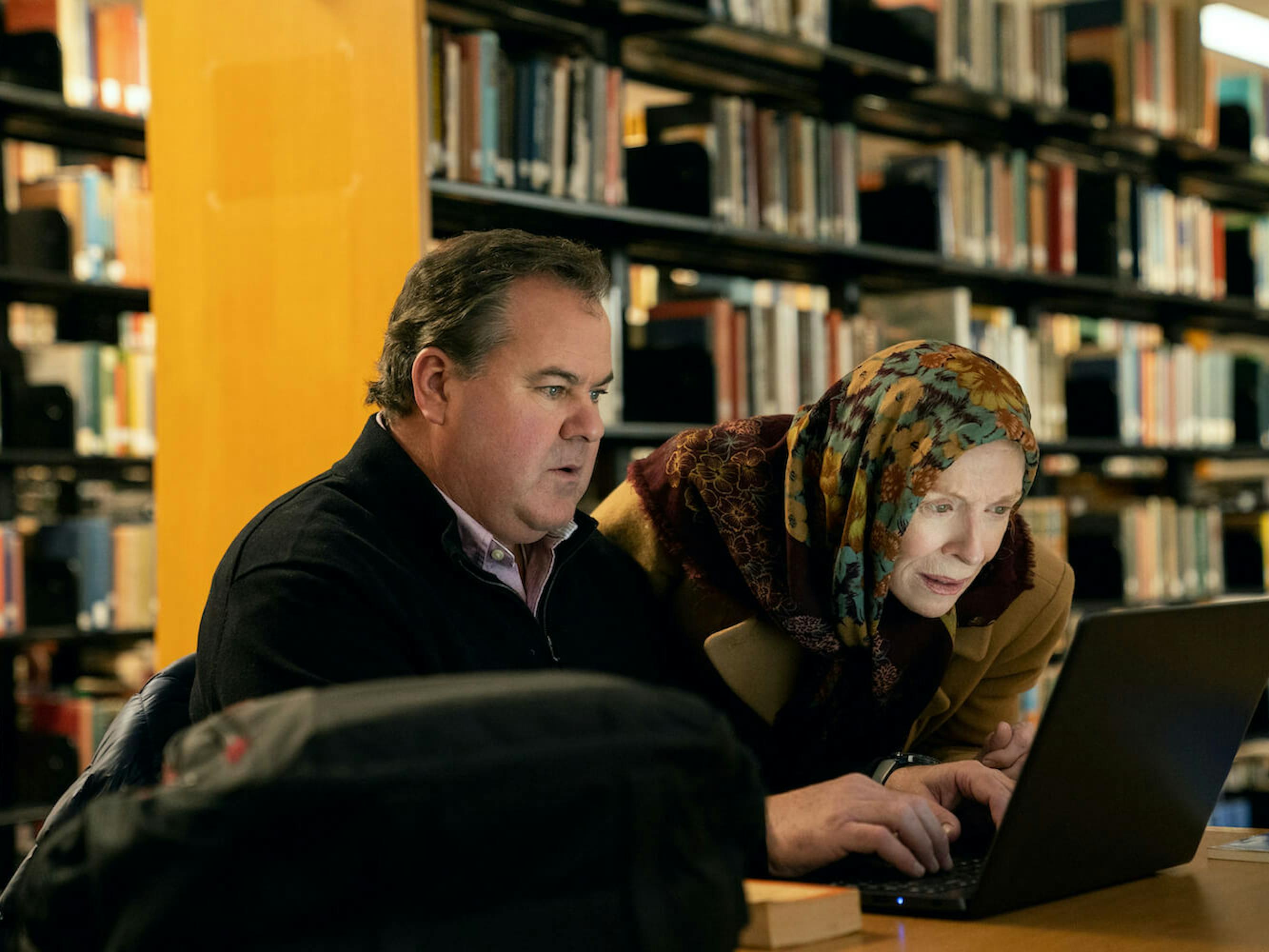
Horatio (Bob Stephenson) and Professor Joan Hambling (Holland Taylor)
Did you take any sort of keepsakes from set?
HT: I took one keepsake and I asked permission if I could. It was a small and extremely lovely, not old, but a very beautiful edition of a book about Chaucer — a biography of what is known of him. It was a very handsome little book, and I asked if I could take it. They said I could. And an article of clothing, a very beautiful white blouse, which I wore in the last scene of the show, with a high neck and a little bit of a ruffled, sort of a triangular front. It was very unlike Holland Taylor and very like Joan Hambling.
Speaking of that, is there anything that you feel like you have in common with your character — personality traits, character traits?
HT: Well, she’s excitable, she’s fun. She enjoys people, but she also has a certain delicacy, and a certain — not frailty — but she’s not as strong as people think she is at all. That would be true of me.
Is there a creature comfort you have on set?
HT: I don’t really have anything. I have to eat a lot; I have to nourish myself constantly. I can feel all gone very easily. I’m always trying to make sure I have some kind of PowerBar or some food nearby because it happens in a flash. I can suddenly feel like I’m going to faint and fall down.
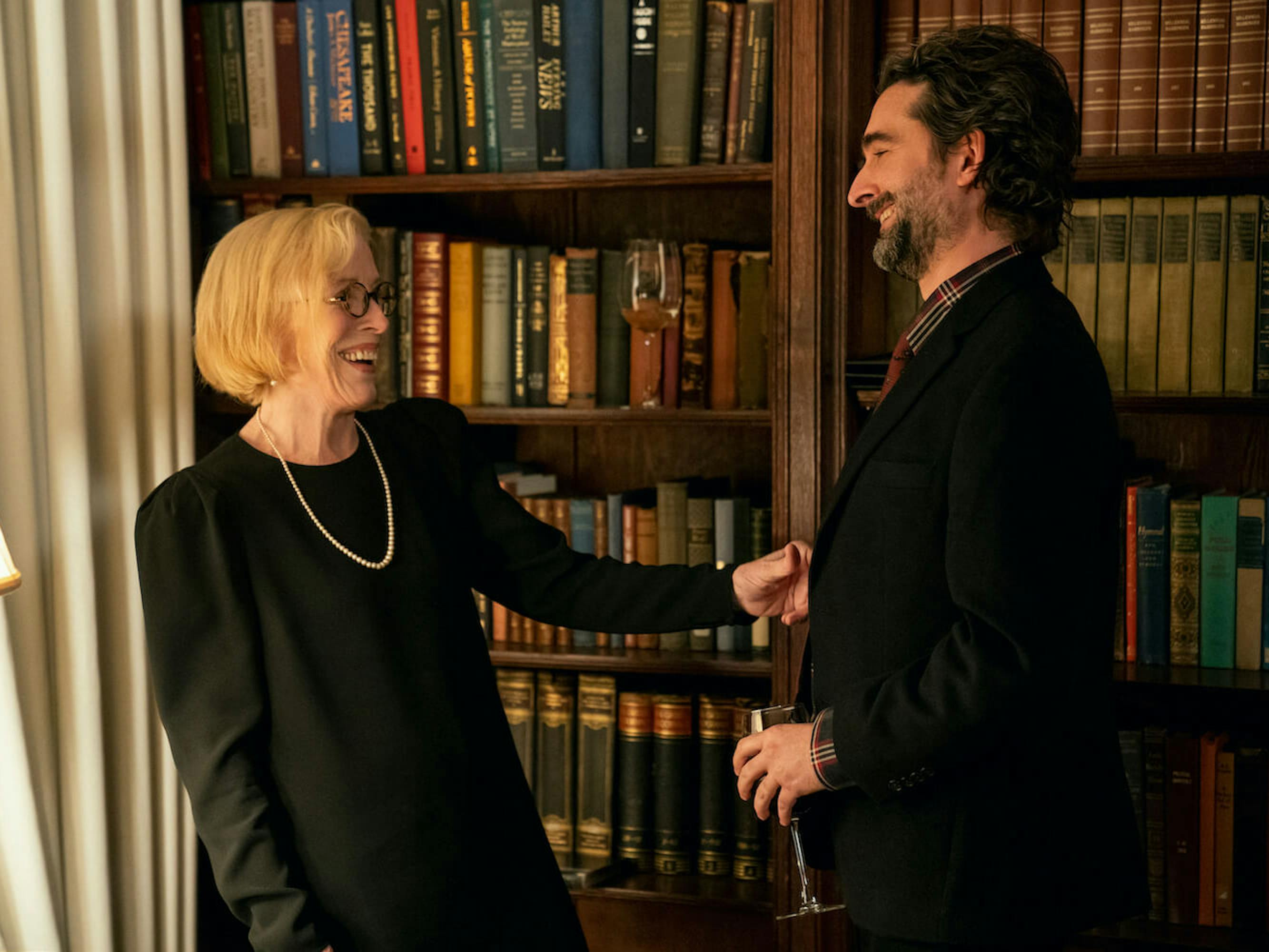
Professor Joan Hambling (Holland Taylor) and Bill Dobson (Jay Duplass)
Is there a dream role or project that you would like to work on?
HT: Gosh, I never thought that way. I want to play great roles and I am wild to get parts that I want, but I don’t do all the other things that people do. I don’t often think up projects I would want to do or pursue some job or call a director and say, “I’ve got to play that part in that movie you’re about to do.” I don’t really think that way.
But there are great roles written for older characters. When an artist decides to put an older character in something, it’s for a great purpose and the roles can be very, very great. Think of things you’ve seen Maggie Smith do. Helen Mirren’s played great roles, and Judi Dench. These roles are fantastic because they were profoundly understood by the authors, and otherwise they just wouldn’t be included. We are not an age-honoring society. I would like to play another great, real person of my age.
